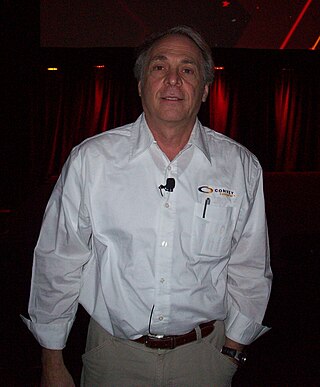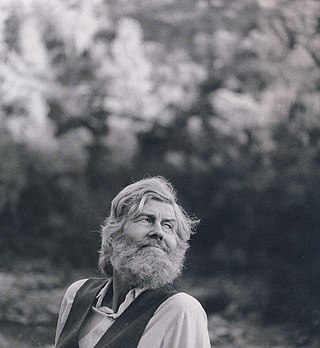Related Research Articles
Michael Max Asher was an American conceptual artist, described by The New York Times as "among the patron saints of the Conceptual Art phylum known as Institutional Critique, an often esoteric dissection of the assumptions that govern how we perceive art." Rather than designing new art objects, Asher typically altered the existing environment, by repositioning or removing artworks, walls, facades, etc.

Steven "Steve" J. Wallach is an engineer, consultant and technology manager. He is a Seymour Cray Computer Engineering Award recipient.

William N. Copley also known as CPLY, was an American painter, writer, gallerist, collector, patron, publisher and art entrepreneur. His works as an artist have been classified as late Surrealist and precursory to Pop Art.
Paul Hambleton Landacre was an American artist based in Los Angeles. His artistic innovations and technical virtuosity gained wood engraving a foothold as a high art form in twentieth-century America. Landacre's linocuts and wood engravings of landscapes, still lifes, nudes, and abstractions are acclaimed for the beauty of their designs and a mastery of materials. He used the finest inks and imported handmade Japanese papers and, with a few exceptions, printed his wood engravings in his studio on a nineteenth-century Washington Hand Press, which is now in the collection of the International Printing Museum in Carson, California.
Alexander Levy (1909–1997), later known as William Alexander Levy, was an American architect who worked principally in Southern California.
Jules Langsner (1911—1967) was an American art critic and psychiatric social worker. Born in New York City in 1911 and died in 1967 in California. Although born in New York, Langsner did not grow up in New York. He and his family moved to Ontario, California shortly after his birth.
Elmer Belt was an internationally recognized urologist, a pioneer in sex-change surgery, an important mover in the founding of the UCLA School of Medicine, and a book collector known for assembling a library of research materials about Leonardo da Vinci—the Elmer Belt Library of Vinciana—which he donated to the University of California, Los Angeles between 1961-66.

John D. Olmsted was a California naturalist and conservationist most famous for creating the Independence Trail in Nevada City, California, as well as helping to save numerous other parcels across California, including Jug Handle State Natural Reserve in Casper, California, Goat Mountain in the Berryessa Snow Mountain Wilderness and the Bridgeport Covered Bridge. His efforts and vision of a park at Bridgeport led to the creation of the South Yuba River State Park, a 39-mile (63 km) length of Nationally protected Wild and Scenic land along the South Yuba River in Nevada County, California. Olmsted patterned his life after that of fellow environmentalist John Muir, with his trademark beard, formal clothing, and poetic and spiritual leanings towards the benefits of time spent in nature.

Fernand Lungren (1857–1932) was an American painter and illustrator. He is mostly known for his paintings of American South Western landscapes and scenes as well as for his earlier New York and European city street scenes.
Kate Steinitz, informally known as “the Mama of Dada,” played a significant role in the history of art on a number of levels: in the creation of her own art works, as a preserver and collector of the art of her times, as a promoter of art and artists, and, for the last thirty years of her life, as a librarian of the Elmer Belt Library of Vinciana, first when the library was based in the collector's medical offices in downtown Los Angeles, and later as honorary curator when the collection was given to UCLA in 1961.
James Hayward is a contemporary abstract painter who lives and works in Moorpark, California. Hayward's paintings are usually divided in two bodies of work: flat paintings (1975-1984) and thick paintings. He works in series, some of which are ongoing, and include The Annunciations, The Stations of the Cross, the Red Maps, Fire Paintings, Smoke Paintings, Sacred and Profane and Nothing's Perfect series.

Eugenia Louise Butler was an American art dealer and collector. In 1963, she became the American representative of Galleria Del Deposito, which featured work by European artists who made functional art objects, such as trays or jewels. She co-directed the Los Angeles Gallery 669 with founder Riko Mizuno from 1967. Butler ran the Eugenia Butler Gallery on La Cienega from 1968 to 1971. Her gallery showed the work of conceptual artists, including John Baldessari, James Lee Byars, Douglas Huebler, and her daughter, Eugenia P. Butler.
Betty Asher was an American art collector and dealer. An ardent supporter of Pop art and Contemporary art, her large collection of cups and saucers by artists was world-famous.
Foundation for Art Resources (FAR) is a Los Angeles-based, non-profit arts organization that facilitates the production and presentation of contemporary art projects outside of the gallery structure. It was founded in 1977 by gallerists Morgan Thomas, Connie Lewallen, and Claire Copley, who transferred leadership to the artist and mediator Dorit Cypis in 1979. Since then, FAR has been overseen collaboratively by over 20 different groups of Board Members and 100 artist-Directors. Currently the longest-running extant arts collective in Los Angeles with no exhibition space, FAR partners with different private, public and educational institutions throughout Los Angeles to produce exhibitions, lectures, and performances with a focus on the relational structures between art, producers, and audience.
Riko Mizuno is a gallerist, art dealer, and artist. Born in Tokyo, Japan, she moved to Los Angeles in the 1950s to study ceramics at Chouinard Art Institute. Between 1966 and 1984, Mizuno operated galleries at three locations in Los Angeles.
Erik d'Azevedo is an American artist and poet who has been active in the San Francisco Bay Area art scene since the late 1970s.
Margarita “Mita” Cuaron is a Chicana curator, visual artist, social activist, educator, and a registered nurse. Born and raised in East Los Angeles, Cuaron utilizes a range of mediums in her artworks such as screen printing, printmaking, watercolor, mixed media, paper mache and more. Margarita “Mita” Cuaron was an active participant in the Chicano Movement and in the 1968 “blowouts” in East Los Angeles schools of the L.A. Unified School District.

Noma Copley was an American fine arts jeweler and art collector noted for her contributions to Surrealist practices and activities. From 1953 through 1968, she was married to William Copley and, with him, helped to acquire one of the largest collections of Surrealist paintings and sculpture in America. In 1954, they established the William and Noma Copley Foundation, a non-profit organization dedicated to fostering the creative arts. According to a 1975 article in New York Magazine, she "emerged from the Paris world of surrealist painters five years ago to become one of New York's most original jewelry designers."
Diana Press Publications was an American feminist publishing house. Founded and established in January 1972 by Coletta Reid and Casey Czarnik, the company was primarily run by a diverse collective of women. It was commercially successful and published radical and feminist literature. Some of their publications included works by Rita Mae Brown, Judy Grahn, and Jeannette Foster. The company was based in Baltimore, Maryland until it relocated to Oakland, California in 1977. Diana Press closed down in 1979.
Astro Artz was an American publishing company founded by Susanna Dakin in the early 1980s.
References
- ↑ Griffin, Jonathan. "The Surrealist Bungalow: William N. Copley and the Copley Galleries (1948-49)." East of Borneo, January 13, 2014 http://www.eastofborneo.org/articles/the-surrealist-bungalow-william-n-copley-and-the-copley-galleries-1948-49
- ↑ Collection Guide for Claire Copley Gallery papers, 1968-2011 (bulk 1973-1977), The Getty Research Institute, Los Angeles, 2014.M.2 http://www.oac.cdlib.org/findaid/ark:/13030/c8959kpf/admin/#did-1.2.1
- ↑ Collection Guide for Claire Copley Gallery papers, 1968-2011 (bulk 1973-1977), The Getty Research Institute, Los Angeles, 2014.M.2 http://www.oac.cdlib.org/findaid/ark:/13030/c8959kpf/admin/#did-1.2.1
- ↑ "PST, A to Z: 'She Accepts,' 'It Happened'". 6 January 2012.
- ↑ Smith, Roberta (10 November 2011). "A New Pin on the Art Map". The New York Times.
- ↑ Collection Guide for Claire Copley Gallery papers, 1968-2011 (bulk 1973-1977), The Getty Research Institute, Los Angeles, 2014.M.2 http://www.oac.cdlib.org/findaid/ark:/13030/c8959kpf/admin/#did-1.2.1
- ↑ Kirsi Peltomäki (2007) Affect and Spectatorial Agency: Viewing Institutional Critique in the 1970s, Art Journal, 66:4, 36-51, DOI:10.1080/00043249.2007.10791282
- ↑ Asher, Michael, and B. H. D. Buchloh. Writings 1973-1983 on Works 1969-1979. The Press of the Nova Scotia College of Art and Design and the Museum of Contemporary Art Los Angeles, 1983, p. 95.
- ↑ "PST, A to Z: 'She Accepts,' 'It Happened'". 6 January 2012.
- ↑ "PST, A to Z: 'She Accepts,' 'It Happened'". 6 January 2012.